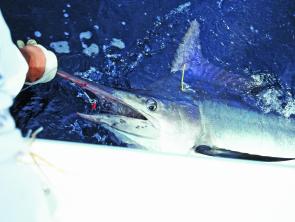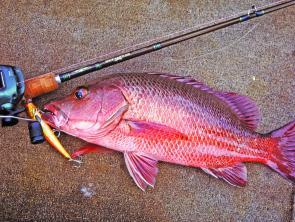Plenty of anglers made it out into the bay during their holidays in December and January. Most returned with good reports of both pelagic and demersal species. In February this action should continue but may taper off a little as the month progresses. Hopefully we will also receive some decent weather, allowing better access to our great fishery. Glassed out days and plentiful pelagic action usually produce memorable times for anglers fishing Moreton Bay in February.
With the recent quality of the fishing in the Bay, this month promises to satisfy angler’s piscatorial itch. Warmer water temperatures should promote baitfish activity, which in turn will attract pelagic species such as mackerel, tuna and bonito. This action should be wide spread throughout the bay, with surface feeding schools discovered as far south as Macleay Island.
The area between Cleveland, Dunwich and The Naval Reserve Banks is a fairly prominent pelagic fishery at this time of the year, which is generally accessible by small craft, even kayak anglers. Schools of spotted and school mackerel often feed along the western edge of the Naval Reserve Banks and also in the main basin and over towards Cleveland. Keeping your eyes peeled is usually the key to success.
Whilst pelagic action (predominately mackerel and tuna) can be found right throughout the bay, key areas such as Measured Mile, Rous Channel, Middle Banks, shipping channels, Pearl Channel and around Gilligans Island are good places to start your search. Schools can pop up in any area on any given day, so having a spin rod rigged and ready to cast with a 15-30g chrome slice will maximize your chance of success. The Western Rocks area is often overlooked by anglers targeting pelagics but regularly holds decent schools mackerel and tuna, especially on a rising tide and early morning before boat traffic becomes too bad.
Anchoring along the edges of the reef surrounding the bay islands as well as the beacons in the northern bay whilst drifting pillies can also produce plenty of school and spotted mackerel. Add a little berley to the equation in the form of chopped pillies and your chances increase.
I love to target sharks in the bay during February and regularly tag double figures of whalers in a day. While I find that 4kg mono will handle the majority of whalers between 5-15kg with ease, most anglers opt for line a little heavier. Whalers, and occasionally hammerheads and other sharks, can be caught throughout the bay and even well up the Brisbane River as far as Mount Crosby.
In the bay, try drifting with whole fish baits (gar, mullet, yakkas, slimies, pike) suspended 4m to 5m below a balloon in areas such as the spoil grounds, shark spit and wide of the bay islands. Add a constant tuna oil slick and you have the recipe for some awesome fun. In the river systems try oily baits (mullet and tuna fillets) or live mullet and catfish for best results but don’t bother to berley.
Anglers with small craft, or those wanting to escape the effects of bad weather periods, can still have a lot of fun in canal systems such as Raby Bay, Aquatic Paradise, Newport Waterways and Horizon Shores. Live baiting these systems with mullet, herring and prawns can produce mangrove jack, estuary cod, trevally, tarpon, bream, flathead and others.
While day sessions can still be worthwhile, the warm February nights usually produce the best action, but don’t forget the insect repellent. Try the deeper holes, rock bars and eddies on the down current side of prominent corners or points and other structure such as jetties and moorings. These same areas can be worked over during night or day with lures such as small hard body minnows, soft plastics and lipless crankbaits.
During recent months there has been a fair bit of bait in the Western Rocks to Yellowpatch area. Species as bizarre as yellowfin, and even a few marlin, have recently been caught here on both live baits and trolled skirted lures. When the boys on the Blackwatch 34 Estiva saw a free jumper here recently on their way out to the Trench they put out the lures and landed one black marlin in 13m of water and another in 17m on Bahama skirted lures. These high quality lures have really caused a stir amongst serious billfish anglers this season and have been one of the hottest lures to have in the water. Recently, black marlin have even been hooked inside the bay proper at areas such as the Curtain Artificial Reef, which just goes to show these species will follow bait anywhere, even into shallower water.
Anglers who yearn for the thrill of a small billfish (15-50kg) have been successfully working areas such as the Trench, Yellowpatch, Hutchies, Flinders and the waters off the Cape to depths of 80m. The area around The Group (off Point Lookout) has also been a pelagic playground and plenty of wahoo, tuna, billfish and a few Spanish mackerel and XOS GT have been caught here on trolled offerings such as skirted resin and metal heads, bibless minnows and bibbed lures.
Many wahoo anglers have been having better success on lures such as Halco Lazer Pro 190 and X-Rap Magnum 30 rather than the traditional high-speed skirted offerings. It pays to mix it up a bit some days to achieve results and weighted skirted-lures such as Hex Heads, Fish Eagle Hex-Jets, Willcatch 8” Hex, Screamers, Hexciters and other high-speed offerings have often solicited strikes when other offerings have failed to produce. Just remember to mix it up a bit until success is achieved.
There are often a few of the larger 20kg plus wahoo around in February. These fish can be caught on the usual lures, but slow trolling a small, live bonito or mack tuna will heighten your chances around structure and current lines. Spanish mackerel will also get in on the action at times during February and are always a welcomed catch.
The action in the Brisbane River should continue this month. Threadfin salmon will be the key species for many anglers working lures and soaking livebaits along the edges of the dropoff into the main river bed anywhere between the mouth and South Bank. These fish can be targeted successfully both during the day and also at night but the darkened hours often produce the better action, especially for those livebaiting with mullet, prawns, herring and the like.
Threadies are not only limited to the lower reaches of the river – schools can often be found feeding all the way up the river, especially at night around lights near jetties, restaurants and other structure. Although a boat is an advantage, there are many landbased spots where threadies can be caught on live baits. Some of the more prominent ones are the Newstead Jetty, Colmslie Jetty and pontoon and around the Gateway Bridge area, although I believe access to this area is a little limited at present. There is also the usual by catch of snapper, cod, flathead, bream and school jew to hope for, but more likely than not you will also tangle with rays, sharks, pike eels and catfish.
Whiting fishing in the bay for the small, yet tasty, summer whiting is a lot of fun especially for the junior or novice angler. Even many old salts enjoy the leisurely pursuit of drifting the channels and banks chasing whiting. February is a great month to try areas such as the Blue Hole, Small Ships Channel, Maroom Banks, Amity Banks, Sand Hills, Browns Gutter and Rous Channel. Use live worms or thin tenderized strips of squid for consistent results and keep shifting until you find some action.
Flathead seem to be a year round proposition now that bag limits and size slots have bolstered their numbers and they can easily be targeted in any estuarine system. While the Pumicestone Passage and Jumpinpin area have a myriad of creeks, gutters, channels and flats to target flathead, there are also some good areas closer to home that are definitely worth the effort.
Some places I have achieved reasonable success chasing lizards include the mouth of Boggy Creek, Lota Creek, the lower Pine River all the way down to the Hornibrook Bridge, Burpengary Creek, Cabbage tree Creek and the Caboolture River. With the growing interest in kayak fishing, these creeks are easily fished by those with only peddle or paddle power. I also like to explore the smaller creeks such as Serpentine and Eprapah in my Kayak. A myriad of other estuarine species such as bream, cod, jacks, trevally, tarpon and whiting are also a possibility when trolling or casting lures or soaking a few baits in these creeks during February.
Crabs will be in full swing this month and now is as good a time as any to set a few pots. For muddies, try any of the estuarine creeks and the canal areas. The Brisbane River even produces some good hauls of crabs with catches as far up as the Indooroopilly stretch. Try setting your pots at the mouth of feeder creeks and inlets and along prominent contours such as ledges.
Good crab baits include fish frames, fish heads and chicken carcasses. The same baits will also work for sand crabs around the mouths of systems leading into the bay and especially further out around the bay islands. Again set your pots along prominent contours and ledges and deeper holes for best results. Whilst leaving your pots out overnight will increase your chances of a better catch, it may also increase the chances of having your pots stolen, so stay close to them at all times and ensure they are labelled correctly.
The full moon in February is usually when the prawns, predominately bananas, run in the Brisbane River and most other systems in the area. A cast net (10ft to 12ft top-pocket net is ideal) is the best way to score a feed of these tasty morsels, with most land-based spots along these systems worth a try. If you have a boat and a colour sounder that you understand the workings of intimately, then you are at decided advantage. Don’t forget that there are limits on the number of prawns you can have in your possession so check current regulations before venturing out.
Overall February is a great month to be out on the waters of Moreton Bay. Even species such as snapper, which are often regarded as winter fare, can still be caught with specific targeting. The pelagic action should be prominent this month although we may be on the downward side of the run. Prawns and crabs are definitely worth the effort in February, which is probably one of the best months for them.
With so much on offer, it pays to mix it up a bit and try your luck at a few disciplines on any day. The hot days make it a pleasure to be out on the water having a fish but don’t forget to consume plenty of water and slip, slop, slap to avoid the effects of the sun. Overall, current indications are that the fishing will be great during February, so check the weather and plan a few trips.
Reads: 1543
Whaler sharks are prevalent in the bay and provide a lot of fun as my girlfriend, Michelle, found out when she recently caught one.

Billfish numbers have been great this summer so far. February should also see some hot action for small blacks.

Hot February days can really bring the mangrove jacks on the chew.




